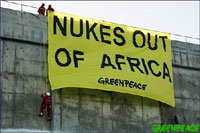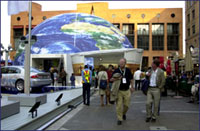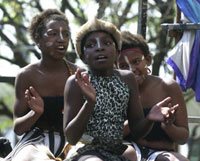Catherine Fedorsky is monitoring energy consumption at the World Summit on Sustainable Development as part of the WSSD Green Energy Project. She is a managing member of Global Environmental Objectives, an environmental consulting firm.
Monday, 26 Aug 2002
JOHANNESBURG, South Africa
The radio wakes me up at 7 a.m. to news of the World Summit on Sustainable Development. The top story: The South African government is seeking an action plan and stresses that the developing world will be expected to implement it. Next: The people planning to protest the WSSD will have to obey the National Riots Security Act, which requires people to register prior to taking to the streets. Hmm. How is a foreign nongovernmental organization supposed to know about this act, much less know how to register? I anticipate some police action; let’s hope no one gets hurt.

Greenpeace banner on the Koeberg Nuclear Power Station.
Photo: Daniel Beltra, Greenpeace.
Daniel Beltra, Greenpeace.
The third radio story reports that 12 Greenpeace activists in Cape Town will be appearing in court today due to their unlawful entry to a “National Key Point” — in this case, Koeberg Nuclear Power Station, located just north of Cape Town. On Saturday, the activists snuck onto the power station property, climbed up the cooling towers, and erected a banner protesting nuclear power. It took the police three hours to catch the protestors — which raises the question of how secure the nuclear plant would be in the event of more insidious trespassing.
After I turn off the radio, I prepare myself for another day in the City of Gold. Johannesburg (also known as Joburg) has Summit Fever. You cannot get away from it. Posters, billboards, advertisements, newspaper headlines, delegates with dog tags around their necks, traffic, transfer buses, street sweepers, police, police, and more police — the summit and its trappings are everywhere you go.
Or perhaps I should say the summits, plural. There are in fact a number of mini-summits, or multiple levels of the same summit, depending on how you choose to look at it. There are four official venues for the WSSD. First, there is the one attended by government representatives, who will be holed up in the Sandton Convention Center talking over issues that the average person on the street will probably never know about. Second, there are those of us hanging out at Ubuntu Village, where there are exhibits about every imaginable issue related to sustainable development. Third, there are the civil society reps and the NGOs, hosted outside the city near Soweto. Fourth, the business agenda is unfolding at the Hilton Hotel, which is hosting corporate interests and the World Business Council for Sustainable Development. In addition, other venues around the city are hosting side events — over 500 of them, and that’s just the official ones.

Sandton Square, outside the convention center.
IISD.
All told, it adds up to an unimaginable number of conferences, lectures, stage performances, posters, flyers, videos, music, handouts, documents, CDs … not to mention national, regional, and provincial governments, companies, NGOs, funding bodies, consulting firms, manufacturers — you name it, and it’s here. Sensory overload, in short. It’s far too much information to actually absorb, so you just have to make the most of it and resign yourself to being overwhelmed.
Luckily, my days are given a little structure because, as part of the WSSD Green Energy Project, I am responsible for reading the energy meter at Ubuntu Village every day. Daily energy consumption figures are also recorded from the other three official venues. The Green Energy Project is coordinated through the South African Department of Environmental Affairs and Tourism with funding from USAID; the energy resources come from wind, solar, bagasse (sugar cane), and mini-hydro projects in South Africa, as well as wind projects in Costa Rica and geothermal energy in Italy. (The last two are obtained through tradable renewable energy certificates.) The sources are enough to meet the energy demand of both Ubuntu Village and NASREC. Energy use is just one of a number of indicators reported to the public every day, including water consumption, waste produced, carbon dioxide emissions and CO2 offsets, to name just a few.
After reading the meter and wandering around the exhibit center for a while, I head back into the traffic, the police, and the road blocks to grab some lunch with my Green Energy Project colleague at Hare Krishna Cuisine — a safe bet for finding vegetarian food and such mottos as “Give Peas a Chance.” The restaurant is full of people from all over the world in search of decent food that won’t cause too many upset stomachs after the heat, the smog, the travel, and the stress of working 12- to 15-hour days.
I’ll get another break this evening, when I head out to the main tent to listen to a bit of local music and drink some South African wine, courtesy of the City of Cape Town. Should be nice to chill with a few fellow Cape Townians and share stories. The day is likely to end around midnight, after I watch the news, wind down (or try to), and prepare for yet another day. The days are very long — but, on the upside, I’m so busy that there’s barely time to think about being tired!
Tuesday, 27 Aug 2002
JOHANNESBURG, South Africa
I am, as they say, reporting live from Ubuntu Village at the World Summit on Sustainable Development in Johannesburg, South Africa. Noise surrounds me. Drums pounding, people singing, cell phones going off, people talking and screaming, equipment whirring, videos blaring, and helicopters flying overhead. You can pretty much forget about concentrating on anything.

One of many distractions: Ubuntu dancers perform at Nasrec.
IISD.
I am in the South African Pavilion, which houses many national organizations, government bodies, and companies. We are located in the section of the tent devoted to energy-related matters, near the National Electricity Regulator, the power utility of South Africa, renewable energy manufacturers, gas, petroleum and biofuels companies, and consulting firms like ourselves devoted to assisting individuals and commercial ventures in energy management.
Some of us are here to assist the Green Energy Project for the WSSD. As I mentioned yesterday, this project is enabling two of the summit venues — Ubuntu Village and Nasrec — to meet their energy demands through green energy (wind, solar, bagasse, mini-hydro, and geothermal). The South Africa Department of Environmental Affairs and Tourism granted the project to AGAMA Energy, with funding from USAID. Additional associates include One World Sustainable Investments, Gailforce Communications, and Green Light Solutions.
Okay, so what is AGAMA Energy? And why are we here? And what does my organization, Global Environmental Objectives, have to do with AGAMA?
Both GEO and AGAMA Energy are based in Cape Town, South Africa. GEO is a small environmental consulting firm focused on ISO 14001 EMS, air quality management, policy and strategy development, and environmental reporting within the energy sector. AGAMA is a consulting company that advises individuals, enterprises, and governments on green energy solutions. This includes policy and strategy development, technical design, installation and maintenance of renewable energy systems for homes, businesses, housing projects, and more.
While AGAMA Energy is primarily a technical energy services company, there is obviously a strong environmental argument for green energy, and the role of GEO is to offer environmental management input to the project. Additionally, GEO assisted in locating green energy sources (both in South Africa and abroad) and is helping monitor and evaluate the impact of green energy during the summit (e.g., calculating carbon emissions avoided through the use of clean energy). This information in turn is submitted to the Greening the WSSD Project and the daily Green Barometer, which is sent to the media and posted on various posters and billboards throughout the summit grounds.
The calculations and evaluations will not be completed for a few weeks following the summit, so I am afraid all of you will have to wait patiently to hear the final tallies on energy use. Until then, let’s hope everything goes well and that a few solid sustainable development decisions will be made — with action plans to support them.

